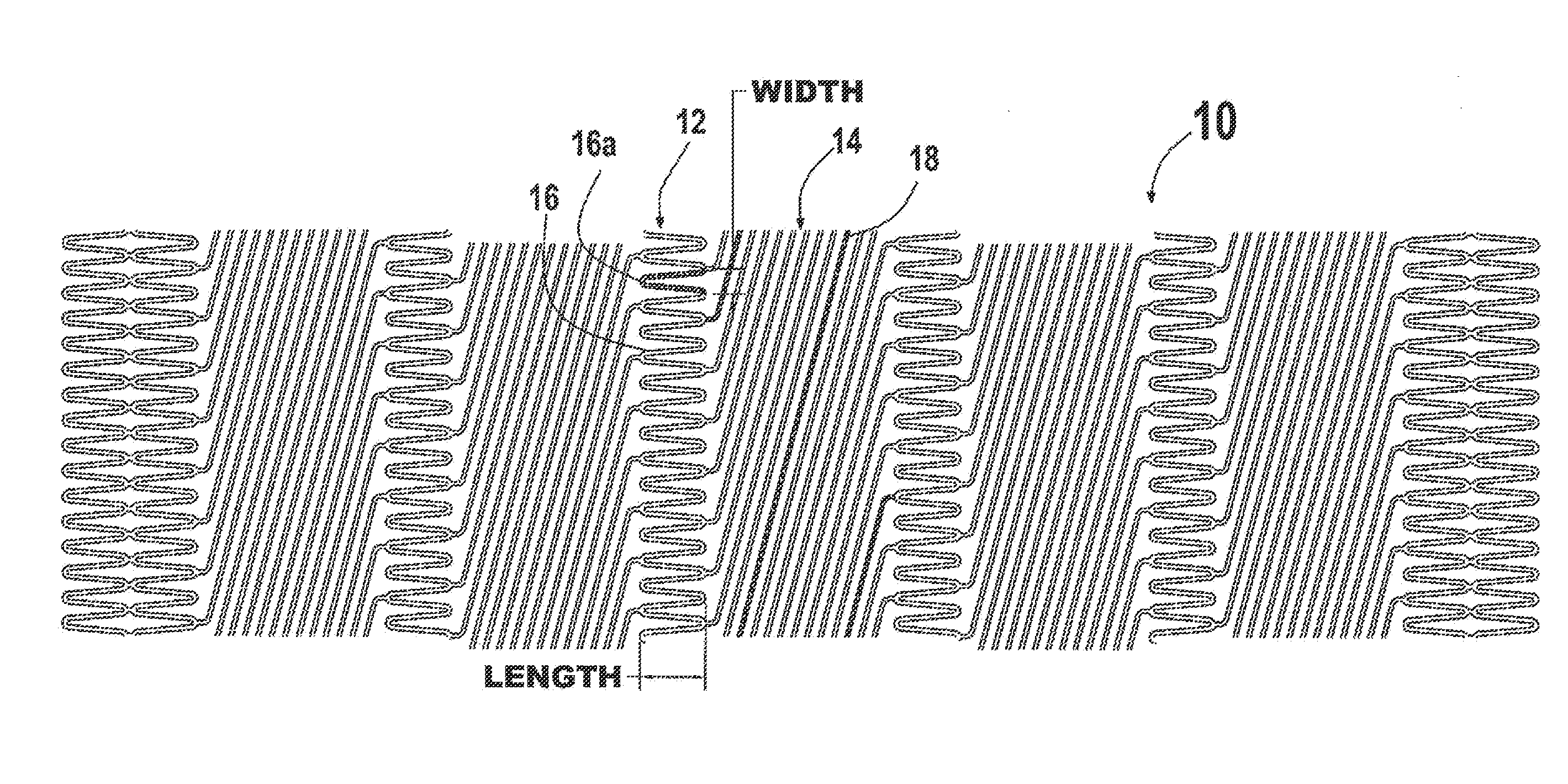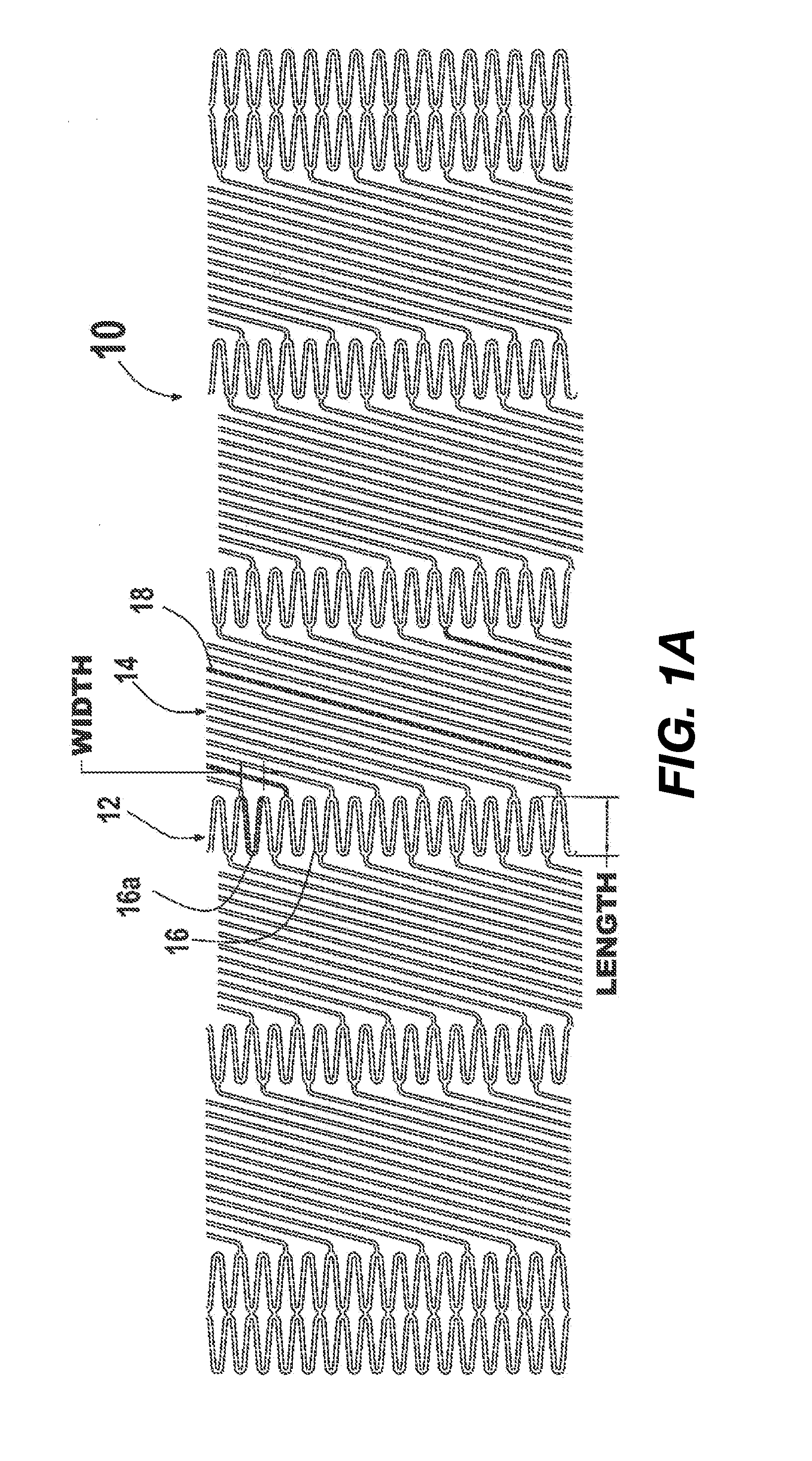Flexible devices
a flexible device and tubular structure technology, applied in the field of expandable tubular structures, can solve the problems of stent failure, stent-like structure problems, stent flexing or bending substantial, etc., and achieve the effects of minimizing cell sizes, maximizing metal coverage, and minimizing metal-to-metal gaps
- Summary
- Abstract
- Description
- Claims
- Application Information
AI Technical Summary
Benefits of technology
Problems solved by technology
Method used
Image
Examples
first embodiment
[0066]FIGS. 1A and 1B are plan views of stent 10 in accordance with the present invention shown in an unexpanded state and expanded state, respectively. As used herein, the term “plan view” will be understood to describe an unwrapped plan view. This could be thought of as slicing open a tubular stent along a line parallel to its axis and laying it out flat. It should therefore be appreciated that, in the actual stent, the top edge of the FIG. 1A will be joined to the lower edge.
[0067]Stent 10 is made from a common material for self expanding stents, such as Nitinol nickel-titanium alloy (Ni / Ti), as is well known in the art. Typically, the stent is laser cut from tubing, for example, with a diameter of about 5 mm (FIG. 1A). It is then expanded and set to a diameter of about 8 mm (FIG. 1B), and for pre-deployment it would be crimped to a diameter appropriate for the application, for example about 2 mm. However, it is contemplated that the present invention is applicable to any type an...
second embodiment
[0071]FIG. 2 is a plan view of stent 20 similar to stent 10 of FIG. 1. The primary differences are in the structure of strut portions 12′ and that there are right-handed and left-handed helical portions (14R and 14L, respectively). Each strut portion 12′ comprises two adjacent strut rings 26, 27 connected by short link 28. The closely opposed peaks of strut elements 26a, 27a are connected by short link 28, so that each strut portion 12′ has a double strut ring structure. It would also be possible to connect multiple strut rings together to form a larger strut portion. The advantage of twin or multiple strut ring strut portions is that they offer increased radial stiffness over the single strut ring strut portion and can stabilize the strut portions so they are less affected by axial forces.
[0072]In a right-handed helical portion 14R, the elements 18 progress clockwise about the surface of stent 10 and, in a left-handed helical portion 14L, they progress counterclockwise. Helical ele...
fourth embodiment
[0074]FIG. 4 is a plan view of a stent in accordance with the present invention. In this case, stent 40 has strut portions 12′ of FIG. 2 and the helical portions 14L, 14R (FIG. 2) and helical portions 34 (FIG. 3). The advantage of this construction is that combining different types of helical elements allows a mix of properties as described herein, providing the opportunity for further optimization of overall stent performance for a given application.
PUM
 Login to View More
Login to View More Abstract
Description
Claims
Application Information
 Login to View More
Login to View More - R&D
- Intellectual Property
- Life Sciences
- Materials
- Tech Scout
- Unparalleled Data Quality
- Higher Quality Content
- 60% Fewer Hallucinations
Browse by: Latest US Patents, China's latest patents, Technical Efficacy Thesaurus, Application Domain, Technology Topic, Popular Technical Reports.
© 2025 PatSnap. All rights reserved.Legal|Privacy policy|Modern Slavery Act Transparency Statement|Sitemap|About US| Contact US: help@patsnap.com



